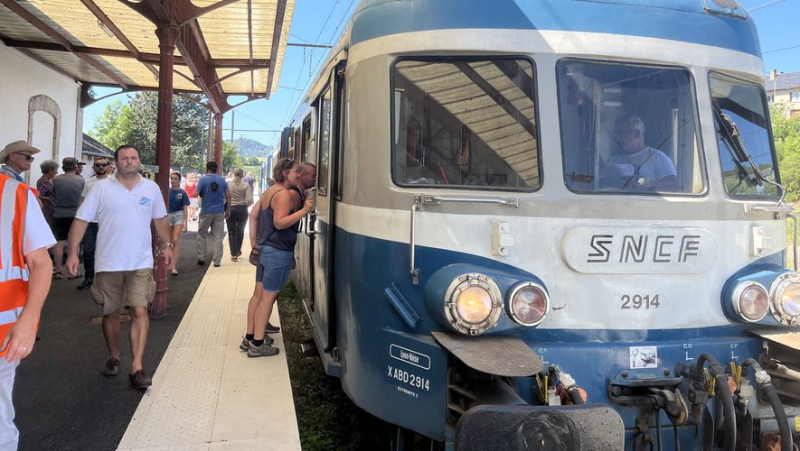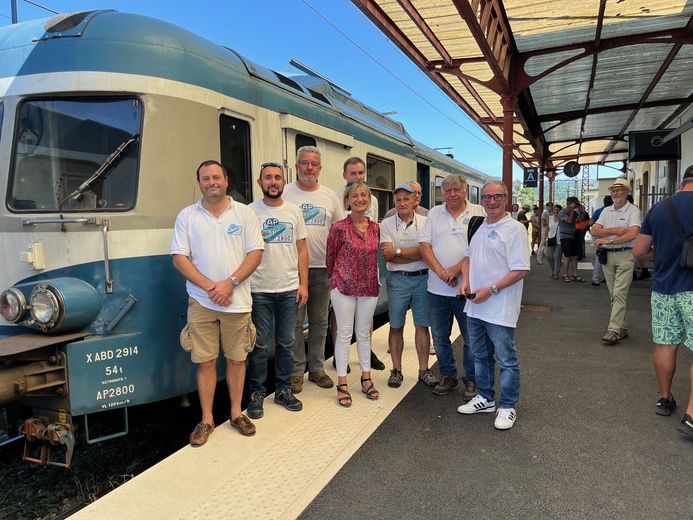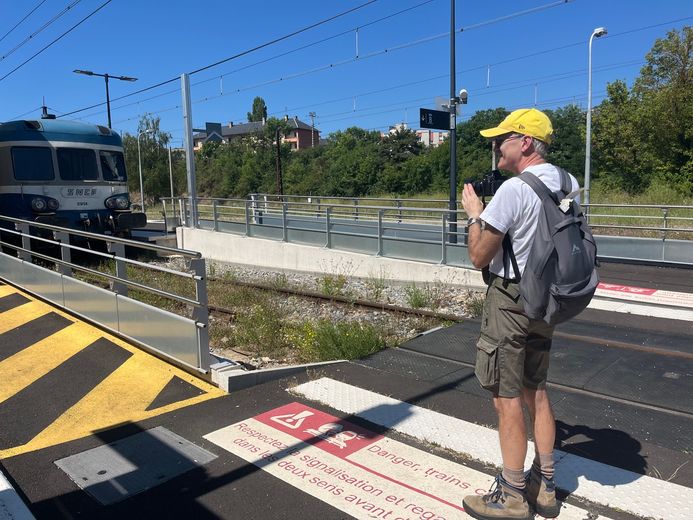The one hundred and forty years of rail in Gévaudan, a successful and lively celebration in Marvejols

Près de 120 personnes étaient à bord du train. Midi Libre – Anaïs Da Silva
The AP 2800 association, with the help of numerous partners, properly celebrated, on Sunday August 11, 2024, the 140th anniversary of rail in Gévaudan.
It is 11:10 a.m. on Sunday, August 11, when a blue train appears on track 1 at Mende station. On the platform, about twenty people wait before boarding this legendary, historic and touristic machine. In total, nearly 120 people are inside. Leaving Langogne at 9:07 a.m., the train passed on the Trans-Lozère rail line, which connects Le Monastier to La Bastide, created to serve Mende.
The composition of the Bleu d'Auvergne train
This is not a regular train belonging to the SNCF. It dates from the 1950s. “We recognize it in particular by its engine sound”, smiles Pierre Ledevin, one of the three drivers of the day, member of the AP 2800 association. The latter, the association Balades ferroviaires en Causses et Cévennes, the Department, the City of Marvejols and the tourist office have joined forces to celebrate 140 years of rail in Gévaudan. “It warms the heart ! Many stations or tracks have been closed, but this one is still there!", underlines the association's maintenance manager.
Jean-Louis Maurin, speaker: “That's real ecology!”
What is the exact date of this anniversary??
It's May 3, 1884, to be precise. The day the train arrived in Mende and Marvejols.
What is the importance of celebrating these 140 years ?
This is not just an important anniversary. It is much more than that. This key date is there to remind us that 140 years ago, Lozère was taking charge of its own railways. We were on a major breakthrough. It is a distant era, certainly, but we cannot understand a society if we do not go back to some important developments such as this one.
What do you think about the future of the train and the rails ?
Currently, there is a lot of competition between rail and motorway in the Lozère area. I am glad that this event is taking place in Marvejols because we tend to forget, in these towns, the importance of railway lines. We will rediscover, in my opinion, in a few years, that if there is a more ecological way to get around, it is the train. At that time, we must not realize that we have abandoned everything… The future will be by train. The electric car is good, but not everyone can afford it. If we design mobility around rails or trams, I think we have a future. That's real ecology!
“This train model was built to run on mountain lines, mainly those of the Jurat and the Massif Central. It is composed of an MGO engine which, at the time, was the most powerful engine for these machines with 825 horsepower”, Pierre Ledevin details meticulously. This railcar has several nicknames: The King of the Mountains and The Blue of Auvergne.
For this event, two vehicles and a trailer, usually parked in Langogne, were present in order to accommodate as many people as possible. The first vehicle, at the head of the procession, dates from 1962, the one at the back from 1958, while the trailer between the two is from 1979.
"We kept the vehicles in their original condition"
"Originally created by Renault, they were red and cream like the Michelines, specifies the enthusiast. Before being recolored blue, giving it its nickname Bleu d’Auvergne." Who says old vehicles, says a lot of maintenance work to take care of them. "You have to be very careful to keep them, says Pierre Ledevin. So we do a lot of work to keep the machines in their original condition."
As passengers head to Marvejols, where many activities await them, the train must respect very specific timetables and speed limits. To run on these rails, the association made a request to the SNCF three months before.

The AP 2800 association at the service of passengers. Midi Libre – Anaïs Da Silva
The opinion of the mayor of Marvejols
Marvejols station was the terminus of the first journey from Langogne. Patricia Brémond, the mayor, was on the platform upon arrival. "These 140 years are symbolic. It is an important date in history. We are fighting for the train to continue. It is not a means of transport of the past, but of the future! We need to return to the train. It is less polluting and safer. Here, in Lozère, we need it to open up our department. And we won't give up anything”, she announced with a smile, proud to host this event. Many activities were organized on site to liven up the day.
A moderate pace
“We are driving between two TER trains, we are not allowed to be late and even less early, he explains. As for speed, that is something else. These trains could travel up to 140 km/h. In the association framework, we are limited to 120 km/h. But that is not a problem because, on these lines, we are on a tourist visit and the maximum speed is 75 km/h on the line. The goal is not to go fast, but to slow down at tourist spots like viaducts and viewpoints so that passengers can admire the scenery. So we go at 45 km/h.” This moderate pace also allows lovers of these machines, posted in suitable locations, to be able to photograph them and keep memories of them.
It is 12:15 p.m. and the train is at Marvejols station.
A Nancy photographer on site

Étienne Collart traveled more than 700 kilometers to participate in the event. Midi Libre – Anaïs Da Silva
Dozens of locals and a few tourists boarded the train. But they weren't the only ones to make the trip. Professional and amateur photographers also got involved for the occasion to immortalize the moment in pictures. Some positioned themselves at strategic locations where the train nicknamed the Bleu d'Auvergne passes, while others preferred to board. This was the case for Étienne Collart, who came specially from Nancy for the weekend. He joined the crew in the first train at Chanac to reach Marvejols. He traveled nearly 700 kilometers, or almost seven hours of driving for the August 11 event.
“It's an old piece of equipment that I knew in the old days”, emphasizes the train enthusiast. So this is not the first time that the man has traveled hundreds of kilometers from home to take pictures of this railcar. He had already been to Provence to admire this machine from the 1950s.
I subscribe to read the rest




